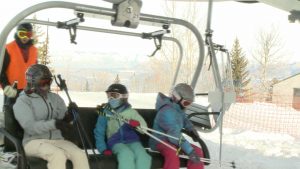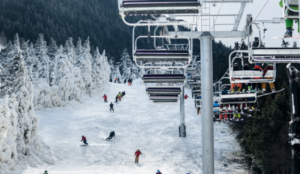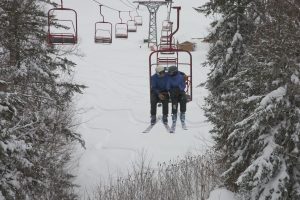For some, riding a chairlift is part of the fun of skiing, allowing for the legs to rest while you take in peaceful sights. For others, riding a chairlift is a necessary evil that you have to do in order to get back up to the top of the run. No doubt, dangling from a chair high off the ground isn’t always a natural feeling.
Whether are one of many who gets a little anxious on chairlifts — which is completely reasonable — or just someone who wants to teach their kids the right way to ride a chairlift, there are a few basic rules. We won’t get into chairlift etiquette — we will lave that one for another time. Rather, here are a few tips for making sure you and your group stay safe on the lifts.
5 Rules for Chairlift Safety
Focus on the mount and dismount.
There are not great statistics on chairlift mishaps, but anecdotes suggest that most issues with chairlift riders happen at the beginning or end of the ride. Getting on a  chairlift, the chair often comes fast. If you are in the wrong position to get on, or have scrambled up to the front of the line and are not ready to sit on the chair, you could have an issue. Put your poles in your hand, peek back to see the chair coming, and sit down when you feel the chair approach your legs. It is as simple as that. As for getting off the lift, it is a good idea to know which way you want to go once you get off the lift, make sure you are not going to run into other riders on your chair, and not be fidgeting with your phone, poles, goggles, etc. when it is your turn to dismount. Once you get off the lift, steadily move away from the space right in front of the dismount area — because within a few seconds, there will be skiers right behind you and they need to be able to move as well. It is best to immediately move 20-25 feet to a flat area before stopping to get your bearings, just to be sure that there is space for the next people on the chair behind you.
chairlift, the chair often comes fast. If you are in the wrong position to get on, or have scrambled up to the front of the line and are not ready to sit on the chair, you could have an issue. Put your poles in your hand, peek back to see the chair coming, and sit down when you feel the chair approach your legs. It is as simple as that. As for getting off the lift, it is a good idea to know which way you want to go once you get off the lift, make sure you are not going to run into other riders on your chair, and not be fidgeting with your phone, poles, goggles, etc. when it is your turn to dismount. Once you get off the lift, steadily move away from the space right in front of the dismount area — because within a few seconds, there will be skiers right behind you and they need to be able to move as well. It is best to immediately move 20-25 feet to a flat area before stopping to get your bearings, just to be sure that there is space for the next people on the chair behind you.
On that note, be cognizant of using chairlifts when you are deciding what to wear skiing. Loose clothing that could catch or easily fall off is not good when you are trying to mount and dismount a chairlift. Everything on you should be well-fitting and not snag or tangle in the parts of the lifts.
Use the bar
Many chairlifts nowadays have a bar that can rest in front of the riders’ torso, and others have a more substantial bar that also includes a footrest. We recommend you use the bar, especially if you are nervous with heights or are riding with children. Having a physical barrier between you and the ground could help in the case of an emergency, but more importantly probably allows nervous riders to not be quite as tense when they are riding the lift. Note that some purists or snowboarders might grumble a little bit if you want to pull the bar down, but you have every right to use the bar even if they don’t want to.
But… be careful of the bar
While we recommend that you use the bar we also have witnessed the bar actually create issues for chairlift riders at the point of dismount. Often, it creates a last-minute scramble as you near the point of getting off the chair, as you try to lift a heavy bar or find that a pole might be caught in the footrest, and that scramble can in itself cause a bit of a headache. Gently raise the bar well before the point of getting off the chair. As for getting on the chair, it is a common courtesy to make sure the others on your chair know the bar is about to come down, just so you don’t smack them in the back of the head.
(make your kids) Face forward and sit still
Chairlifts are generally pretty safe, but they are not amusement park rides. Especially if you are riding with children, you may want to remind them that the only safe way to ride is to face forward. We often see kids turning around, joking with the people on the chair behind them, and that makes us pretty nervous. Also, never bounce the chair. A good chairlift is made of a very heavy cable on pulleys. It is not meant to be bounced, something that we sometimes see. We don’t want to point fingers, but teenage boys tend to be the offenders on this one. The simple old saying that we love — bottom on bottom, and back on back. Have your bottom on the chairlift seat, and have your back on against the chairlift back.
Pick the right lifts
If you are a Nervous Nelly when it comes to chairlifts and have some anxiety when riding them, do some research on the ski area you will be at and try to stick to the right lifts. Any type of high-speed lift usually  has the bar and often a footrest, which can take a bit of the edge off when riding. Also, you will get to know the various lifts, and if there is one in particular that goes higher off the ground than you are comfortable with or has other qualities that bother you, try to find runs you like closer to the lifts that you enjoy riding. For people who really hate chairlifts, they might want to focus on a ski area that relies more on gondolas and trams.
has the bar and often a footrest, which can take a bit of the edge off when riding. Also, you will get to know the various lifts, and if there is one in particular that goes higher off the ground than you are comfortable with or has other qualities that bother you, try to find runs you like closer to the lifts that you enjoy riding. For people who really hate chairlifts, they might want to focus on a ski area that relies more on gondolas and trams.
Also, be aware of your backpack. If you are someone who likes to ski with a backpack, or someone how likes to carry your lunch with you in a backpack oufitted with a cooler, these things cause you to have to sit further forward on the lift with an awkward forward-leaning gait. Some people don’t mind at all, but for others, this subtle positioning alteration can feel quite unnatural and unsafe.
Of course, there are way more than 5 rules for keeping yourself safe and secure on chairlifts. Just remember, treat them with respect, remember that you are dangling at heights that require some precautions, but relax and realize you are in good hands. Chairlifts accidents are incredibly rare — you are much more likely to hit another skier while skiing. Most of all, use some common sense and you will enjoy getting up the mountain almost as much as getting down.

Paul Miller is the Founder of Family Skier. He is an advanced skier and has extensive experience with family travel and ski schools. An accomplished skier, he has skied in 15 states and provinces and 6 countries. In addition to FamilySkier, his writing can be found on many ski-related websites, and as curriculum for many ski clubs in North America.




